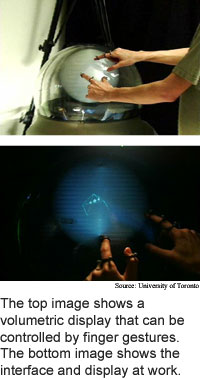
Gestures control true 3D display
How do you interact with a display that
contains depth as well as height and width?
Researchers from the University of Toronto have put together a
system that allows for direct gestural interaction with virtual objects
contained in a volumetric display.
Volumetric displays occupy a volume of space, like a crystal ball.
The challenge in interacting with a volumetric display is akin to pointing
out objects in a crystal ball.
The researchers' method involves using fingers to gesture in the
space around and on the surface of the volumetric display. The user's
finger positions and postures are tracked by a set of four cameras.
Any application that displays three-dimensional graphics can make
use of the volumetric display interaction technique. It could eventually
be used as an interface for three-dimensional medical, architectural and
graphic design applications, according to the researchers.
The interface includes two-dimensional menus projected on the
surface of the display and a browser for selecting three-dimensional objects
used to construct models. The browser uses a grid that contains three-dimensional
images of objects like cubes, spheres and pyramids.
Using finger gestures, users can point at objects, make gestures
to trigger commands, and manipulate three-dimensional models projected
in the display, including moving, rotating and resizing the models or
portions of the models.
It will be 10 to 20 years before the device can be used for practical
applications, according to the researchers. The work was presented at
the User Interface Software and Technology 2004 (UIST '04) conference
held October 24 to 27 in Santa Fe, New Mexico.
TRN's Top Picks:
Technology Research Advances of 2004
Letter to readers
Briefs:
Alcohol fuel cell goes micro
LED array turned into touch button
Coated nanotubes make biosensors
Gestures control true 3D display
Atom demo fixes quantum errors
Virtual turntable simplifies sharing
Molecular motor goes both ways
Solar cell teams plastic and carbon
DNA makes and breaks particle clumps
Sapphire steps shape nanotubes arrays

Research Watch blog
View from the High Ground Q&A
How It Works
RSS Feeds:
News
Ad links:
Buy an ad link
Ad links: Clear History
Buy an ad link
|
TRN
Newswire and Headline Feeds for Web sites
|
© Copyright Technology Research News, LLC 2000-2010. All rights reserved.